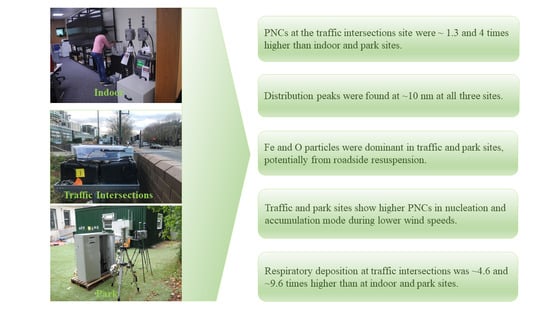Particle Number Size Distribution in Three Different Microenvironments of London
Abstract
:1. Introduction
2. Materials and Methods
2.1. Site Description
2.2. Instrumentation
2.3. Data Collection
2.4. Scanning Transmission Electron Microscopy with Energy Dispersive X-ray Spectroscopy (STEM-EDX) Analysis
2.5. Data Analyses
2.6. Estimation of Respiratory Deposition Doses (RDDs)
3. Results
3.1. PNDs in Different Microenvironments
3.2. PNDs during Morning Peak Hours
3.3. PNCs in Different Microenvironments
3.4. Effect of Meteorology on PNCs
3.5. Characterisation of PM from Different Environments
3.6. Respiratory Deposition Doses
4. Conclusions
Supplementary Materials
Author Contributions
Funding
Institutional Review Board Statement
Informed Consent Statement
Data Availability Statement
Acknowledgments
Conflicts of Interest
References
- Kumar, P.; Morawska, L.; Birmili, W.; Paasonen, P.; Hu, M.; Kulmala, M.; Harrison, R.M.; Norford, L.; Britter, R. Ultra fine particles in cities. Environ. Int. 2014, 66, 1–10. [Google Scholar] [CrossRef] [PubMed]
- Li, L.; Hu, J.; Li, J.; Gong, K.; Wang, X.; Ying, Q.; Qin, M.; Liao, H.; Guo, S.; Hu, M.; et al. Modelling air quality during the EXPLORE-YRD campaign—Part II. Regional source apportionment of ozone and PM2.5. Atmos. Environ. 2021, 247, 118063. [Google Scholar] [CrossRef]
- Liu, C.; Hu, H.; Zhou, S.; Chen, X.; Hu, Y.; Hu, J. Change of composition, source contribution, and oxidative effects of environmental PM2.5 in the respiratory tract. Environ. Sci. Technol. 2023, 57, 11605–11611. [Google Scholar] [CrossRef] [PubMed]
- Liu, C.; Wang, H.; Guo, H. Redistribution of PM2.5 -associated nitrate and ammonium during outdoor-to-indoor transport. Indoor Air 2019, 29, 460–468. [Google Scholar] [CrossRef] [PubMed]
- Tiwari, A.; Kumar, P. Quantification of green infrastructure effects on airborne nanoparticles dispersion at an urban scale. Sci. Total Environ. 2022, 838, 155778. [Google Scholar] [CrossRef] [PubMed]
- Harrison, R.M.; Beddows, D.C.S.; Alam, M.S.; Singh, A.; Brean, J.; Xu, R.; Kotthaus, S.; Grimmond, S. Interpretation of particle number size distributions measured across an urban area during the FASTER campaign. Atmos. Chem. Phys. 2019, 19, 39–55. [Google Scholar] [CrossRef]
- Rivas, I.; Beddows, D.C.S.; Amato, F.; Green, D.C.; Järvi, L.; Hueglin, C.; Reche, C.; Timonen, H.; Fuller, G.W.; Niemi, J.V.; et al. Source apportionment of particle number size distribution in urban background and traffic stations in four European cities. Environ. Int. 2020, 135, 105345. [Google Scholar] [CrossRef]
- Kumar, P.; Pirijola, L.; Ketzel, M.; Harrison, R.M. Nanoparticle emissions from 11 non-vehicle exhaust sources—A review. Atmos. Environ. 2013, 67, 252–277. [Google Scholar] [CrossRef]
- Kumar, P.; Robins, A.; Vardoulakis, S.; Britter, R. A review of the characteristics of nanoparticles in the urban atmosphere and the prospects for developing regulatory controls. Atmos. Environ. 2010, 44, 5035–5052. [Google Scholar] [CrossRef]
- Han, D.; Chen, R.; Kan, H.; Xu, Y. The Bio-distribution, Clearance Pathways, and Toxicity Mechanisms of Ambient Ultrafine Particles. Eco-Environ. Health 2023, 2, 95–106. [Google Scholar] [CrossRef]
- Moreno-Ríos, L.A.; Tejeda-Benítez, L.P.; Bustillo-Lecompte, F.C. Sources, characteristics, toxicity, and control of ultrafine particles: An overview. Geosci. Front. 2022, 13, 101147. [Google Scholar] [CrossRef]
- Kumar, P.; Zavala-Reyes, J.C.; Kalaiarasan, G.; Abubakar-Waziri, H.; Young, G.; Mudway, I.; Dilliway, C.; Lakhdar, R.; Mumby, S.; Kłosowski, M.M.; et al. Characteristics of fine and ultrafine aerosols in the London underground. Sci. Total Environ. 2023, 858, 159315. [Google Scholar] [CrossRef] [PubMed]
- Schiavo, B.; Morton-Bermea, O.; Meza-Figueroa, D.; Acosta-Elías, M.; González-Grijalva, B.; Armienta-Hernández, M.A.; Inguaggiato, C.; Valera-Fernández, D. Characterization and Polydispersity of Volcanic Ash Nanoparticles in Synthetic Lung Fluid. Toxics 2023, 11, 624. [Google Scholar] [CrossRef]
- Newby, D.E.; Mannucci, P.M.; Tell, G.S.; Baccarelli, A.A.; Brook, R.D.; Donaldson, K.; Forastiere, F.; Franchini, M.; Franco, O.H.; Graham, I.; et al. Expert position paper on air pollution and cardiovascular disease. Eur. Heart J. 2015, 36, 83–93. [Google Scholar] [CrossRef] [PubMed]
- Schwarz, M.; Schneider, A.; Cyrys, J.; Bastian, S.; Breitner, S.; Peters, A. Impact of ultrafine particles and total particle number concentration on five cause-specific hospital admission endpoints in three German cities. Environ. Int. 2023, 178, 108032. [Google Scholar] [CrossRef] [PubMed]
- Tomson, M.; Kumar, P.; Kalaiarasan, G.; Zavala-Reyes, J.C.; Chiapasco, M.; Sephton, M.A.; Young, G.; Porter, E.A. Pollutant concentrations and exposure variability in four urban microenvironments of London. Atmos. Environ. 2023, 298, 119624. [Google Scholar] [CrossRef]
- Diapouli, E.; Chaloulakou, A.; Spyrellis, N. Levels of ultrafine particles in different microenvironments—Implications to children exposure. Sci. Total Environ. 2007, 388, 128–136. [Google Scholar] [CrossRef]
- de Kluizenaar, Y.; Kuijpers, E.; Eekhout, I.; Voogt, M.; Vermeulen, R.C.H.; Hoek, G.; Sterkenburg, R.P.; Pierik, F.H.; Duyzer, J.H.; Meijer, E.W.; et al. Personal exposure to UFP in different micro-environments and time of day. Build. Environ. 2017, 122, 237–246. [Google Scholar] [CrossRef]
- Harni, S.D.; Saarikoski, S.; Kuula, J.; Helin, A.; Aurela, M.; Niemi, J.V.; Kousa, A.; Rönkkö, T.; Timonen, H. Effects of emission sources on the particle number size distribution of ambient air in the residential area. Atmos. Environ. 2023, 293, 119419. [Google Scholar] [CrossRef]
- Patel, S.; Sankhyan, S.; Boedicker, E.K.; DeCarlo, P.F.; Farmer, D.K.; Goldstein, A.H.; Katz, E.F.; Nazaroff, W.W.; Tian, Y.; Vanhanen, J.; et al. Indoor Particulate Matter during HOMEChem: Concentrations, Size Distributions, and Exposures. Environ. Sci. Technol. 2020, 54, 7107–7116. [Google Scholar] [CrossRef]
- Abhijith, V.K.; Kumar, P. Field investigations for evaluating green infrastructure effects on air quality in open-road conditions. Atmos. Environ. 2019, 201, 132–147. [Google Scholar] [CrossRef]
- Kero, I.; Naess, K.M.; Tranell, G. Particle size distributions of particulate emissions from the ferroalloy industry evaluated by electrical low pressure impactor (ELPI). J. Occup. Environ. Hyg. 2015, 12, 37–44. [Google Scholar] [CrossRef] [PubMed]
- Al-Dabbous, A.N.; Kumar, P. Number and Size Distribution of Airborne Nanoparticles during Summertime in Kuwait: First Observations from the Middle East. Environ. Sci. Technol. 2014, 48, 13634–13643. [Google Scholar] [CrossRef] [PubMed]
- Ragettli, M.S.; Corradi, E.; Braun-Fahrländer, C.; Schindler, C.; de Nazelle, A.; Jerrett, M.; Ducret-Stich, E.R.; Künzli, N.; Phuleria, H.C. Commuter exposure to ultrafine particles in different urban locations, transportation modes and routes. Atmos. Environ. 2013, 77, 376–384. [Google Scholar] [CrossRef]
- Betha, R.; Selvam, V.; Blake, D.R.; Balasubramanian, R. Emission characteristics of ultrafine particles and volatile organic compounds in a commercial printing center. J. Air Waste Manag. Assoc. 2011, 11, 1093–1101. [Google Scholar] [CrossRef]
- Cattaneo, A.; Garramone, G.; Taronna, M.; Peruzzo, C.; Cavallo, M.D. Personal exposure to airborne ultrafine particles in the urban area of Milan. J. Phys. Conf. Ser. 2009, 151, 012039. [Google Scholar] [CrossRef]
- Kumar, P.; Fennell, P.; Britter, R. Measurements of particles in the 5–1000 nm range close to road level in an urban street canyon. Sci. Total Environ. 2008, 390, 437–447. [Google Scholar] [CrossRef]
- Agus, E.L.; Young, D.T.; Lingard, J.J.N.; Smalley, R.J.; Tate, J.E.; Goodman, P.S.; Tomlin, A.S. Factors influencing particle number concentrations, size distributions and modal parameters at a roof-level and roadside site in Leicester, UK. Sci. Total Environ. 2007, 386, 65–82. [Google Scholar] [CrossRef]
- Goel, A.; Kumar, P. A review of fundamental drivers governing the emissions, dispersion, and exposure to vehicle-emitted nanoparticles at signalised traffic intersections. Atmos. Environ. 2014, 97, 316–331. [Google Scholar] [CrossRef]
- Tsang, H.; Kwok, R.; Miguel, A.H. Pedestrian Exposure to Ultrafine Particles in Hong Kong Under Heavy Traffic Conditions. Aerosol Air Qual. Res. 2008, 8, 19–27. [Google Scholar] [CrossRef]
- Argyropoulos, G.; Samara, C.; Voutsa, D.; Kouras, A.; Manoli, E.; Voliotis, A.; Tsakis, A.; Chasapidis, L.; Konstandopoulos, A.; Eleftheriadis, K. Concentration levels and source apportionment of ultrafine particles in road microenvironments. Atmos. Environ. 2016, 129, 68–78. [Google Scholar] [CrossRef]
- Koivisto, A.J.; Hussein, T.; Niemelä, R.; Tuomi, T.; Hämeri, K. Impact of particle emissions of new laser printers on modeled office room. Atmos. Environ. 2010, 44, 2140–2146. [Google Scholar] [CrossRef]
- Shrestha, P.M.; Humphrey, J.L.; Carlton, E.J.; Adgate, J.L.; Barton, K.E.; Root, E.D.; Miller, L.S. Impact of Outdoor Air Pollution on Indoor Air Quality in Low-Income Homes during Wildfire Seasons. Int. J. Environ. Res. Public Health 2019, 16, 3535. [Google Scholar] [CrossRef] [PubMed]
- Setyawati, M.I.; Singh, D.; Krishnan, S.P.R.; Huang, H.; Wang, M.; Shenglan, J.; Bernice Huan Rong, G.; Chin Guan, H.; Ridhwan, Y.; Mustafa, H.K.; et al. Occupational Inhalation Exposures to Nanoparticles at Six Singapore Printing Centers. Environ. Sci. Technol. 2020, 54, 2389–2400. [Google Scholar] [CrossRef] [PubMed]
- Martin, J.; Demokritou, P.; Woskie, S.; Bello, D. Indoor Air Quality in Photocopy Centers, Nanoparticle Exposures at Photocopy Workstations, and the Need for Exposure Controls. Ann. Work. Expo. Health 2017, 61, 110–122. [Google Scholar] [PubMed]
- Morawska, L.; He, C.; Johnson, G.; Jayaratne, R.; Salthammer, T.; Wang, H.; Uhde, E.; Bostrom, T.; Modini, R.; Ayoko, G.; et al. An Investigation into the Characteristics and Formation Mechanisms of Particles Originating from the Operation of Laser Printers. Environ. Sci. Technol. 2009, 43, 1015–1022. [Google Scholar] [CrossRef] [PubMed]
- Kumar, P.; Hama, S.; Alaa Abbass, R.; Nogueira, T.; Brand, V.S.; Wu, H.W.; Abulude, F.O.; Adelodun, A.A.; Anand, P.; Fatima Andrade, M.; et al. In-kitchen aerosol exposure in twelve cities across the globe. Environ. Int. 2022, 162, 107155. [Google Scholar] [CrossRef]
- Brines, M.; Dall’Osto, M.; Beddows, D.C.S.; Harrison, R.M.; Gómez-Moreno, F.; Núñez, L.; Artíñano, B.; Costabile, F.; Gobbi, G.P.; Salimi, F.; et al. Traffic and nucleation events as main sources of ultrafine particles in high-insolation developed world cities. Atmos. Chem. Phys. 2015, 15, 5929–5945. [Google Scholar] [CrossRef]
- Vratolis, S.; Fini, M.I.; Bezantakos, S.; Stavroulas, I.; Kalivitis, N.; Kostenidou, E.; Louvaris, E.; Siakavaras, D.; Biskos, G.; Mihalopoulos, N.; et al. Particle number size distribution statistics at City-Centre Urban Background, urban background, and remote stations in Greece during summer. Atmos. Environ. 2019, 213, 711–726. [Google Scholar] [CrossRef]
- Goel, A.; Kumar, P. Vertical and horizontal variability in airborne nanoparticles and their exposure around signalised traffic intersections. Environ. Pollut. 2016, 214, 54–69. [Google Scholar] [CrossRef]
- Asmi, A.; Wiedensohler, A.; Laj, P.; Fjaeraa, A.M.; Sellegri, K.; Birmili, W.; Weingartner, E.; Baltensperger, U.; Zdimal, V.; Zikova, N.; et al. Number size distributions and seasonality of submicron particles in Europe 2008–2009. Atmos. Chem. Phys. 2011, 11, 5505–5538. [Google Scholar] [CrossRef]
- R Core Team. R: A Language and Environment for Statistical Computing. Available from R Foundation for Statistical Computing, Vienna, Austria. 2020. Available online: https://www.R-project.org/ (accessed on 26 November 2020).
- Carslaw, D.C.; Ropkins, K. Openair—An R package for air quality data analysis. Environ. Model. Softw. 2012, 27, 52–61. [Google Scholar] [CrossRef]
- Voliotis, A.; Karali, I.; Kouras, A.; Samara, C. Fine and ultrafine particle doses in the respiratory tract from digital printing operations. Environ. Sci. Pollut. Res. 2017, 24, 3027–3037. [Google Scholar] [CrossRef] [PubMed]
- Joodatnia, P.; Kumar, P.; Robins, A. The behaviour of traffic produced nanoparticles in a car cabin and resulting exposure rates. Atmos. Environ. 2013, 65, 40–51. [Google Scholar] [CrossRef]
- Hinds, W.C. Aerosol Technology: Properties, Behaviour and Measurement of Airborne Particles; John Wiley & Sons: Chichester, UK, 1999. [Google Scholar]
- Chalupa, D.C.; Morrow, P.E.; Oberdörster, G.; Utell, M.J.; Frampton, M.W. Ultrafine particle deposition in subjects with asthma. Environ. Health Perspect. 2004, 112, 879–882. [Google Scholar] [CrossRef] [PubMed]
- Goel, A.; Kumar, P. Characterisation of nanoparticle emissions and exposure at traffic intersections through fast-response mobile and sequential measurements. Atmos. Environ. 2015, 107, 374–390. [Google Scholar] [CrossRef]
- Morawska, L.; Ristovski, Z.; Jayaratne, E.R.; Keogh, D.U.; Ling, X. Ambient nano, and ultrafine particles from motor vehicle emissions: Characteristics, ambient processing, and implications on human exposure. Atmos. Environ. 2008, 42, 8113–8138. [Google Scholar] [CrossRef]
- Vu, T.V.; Delgado-Saborit, J.M.; Harrison, R.M. Review: Particle number size distributions from seven major sources and implications for source apportionment studies. Atmos. Environ. 2015, 122, 114–132. [Google Scholar] [CrossRef]
- Chatain, M.; Alvarez, R.; Ustache, A.; Rivière, E.; Favez, O.; Pallares, C. Simultaneous Roadside and Urban Background Measurements of Submicron Aerosol Number Concentration and Size Distribution (in the Range 20–800 nm), along with Chemical Composition in Strasbourg, France. Atmosphere 2021, 12, 71. [Google Scholar] [CrossRef]
- Kuuluvainen, H.; Rönkkö, T.; Järvinen, A.; Saari, S.; Karjalainen, P.; Lähde, T.; Pirjola, L.; Niemi, J.V.; Hillamo, R.; Keskinen, J. Lung deposited surface area size distributions of particulate matter in different urban areas. Atmos. Environ. 2016, 136, 105–113. [Google Scholar] [CrossRef]
- Kumar, P.; Goel, A. Concentration dynamics of coarse and fine particulate matter at and around signalised traffic intersections. Environ. Sci. Process. Impacts 2016, 18, 1220. [Google Scholar] [CrossRef] [PubMed]
- Holmes, N.S.; Morawska, L.; Mengersen, K.; Jayaratne, E.R. Spatial distribution of sub micrometre particles and CO in an urban microscale environment. Atmos. Environ. 2005, 39, 3977–3988. [Google Scholar] [CrossRef]
- Isaxon, C.; Gudmundsson, A.; Nordin, E.Z.; Lönnblad, L.; Dahl, A.; Wieslander, G.; Bohgard, M.; Wierzbicka, A. Contribution of indoor-generated particles to residential exposure. Atmos. Environ. 2015, 106, 458–466. [Google Scholar] [CrossRef]
- Abt, E.; Suh, H.H.; Allen, G.; Koutrakis, P. Characterization of Indoor Particle Sources: A Study Conducted in the Metropolitan Boston Area. Environ. Health Perspect. 2000, 108, 35–44. [Google Scholar] [CrossRef] [PubMed]
- di Bucchianico, A.M.; Cusano, M.; Gaddi, R.; Gaeta, A.; Leone, G.; Boccuni, F.; Ferrante, R.; Pelliccioni, A.; Cattani, G. Indoor and Outdoor Particle Number Concentration in the Sapienza University Campus of Rome. Sustainability 2021, 13, 9126. [Google Scholar] [CrossRef]
- Qian, J.; Ferro, A.R. Resuspension of dust particles in a chamber and associated environmental factors. Aerosol Sci. Technol. 2008, 42, 566–578. [Google Scholar] [CrossRef]
- Quang, T.N.; He, C.; Morawska, L.; Knibbs, L.D. Influence of ventilation and filtration on indoor particle concentrations in urban office buildings. Atmos. Environ. 2013, 79, 41–52. [Google Scholar] [CrossRef]
- Guo, S.; Hu, M.; Peng, J.; Wu, Z.; Zamora, M.L.; Shang, D.; Du, Z.; Zheng, J.; Fang, X.; Tang, R.; et al. Remarkable nucleation and growth of ultrafine particles from vehicular exhaust. Proc. Natl. Acad. Sci. USA 2020, 117, 3427–3432. [Google Scholar] [CrossRef]
- Mc Garry, P.; Morawska, L.; He, C.; Jayaratne, R.; Falk, M.; Tran, Q.; Wang, H. Exposure to particles from laser printers operating within office workplaces. Environ. Sci. Technol. 2011, 45, 6444–6452. [Google Scholar] [CrossRef]
- Schneider, I.L.; Teixeira, E.C.; Silva, L.F.O.; Wiegand, F. Atmospheric particle number concentration and size distribution in a traffic–impacted area. Atmos Pollut. Res. 2015, 6, 877–885. [Google Scholar] [CrossRef]
- Santos-Juusela, V.D.; Petäjä, T.; Kousa, A.; Hämeri, K. Spatial-temporal variations of particle number concentrations between a busy street and the urban background. Atmos. Environ. 2013, 79, 324–333. [Google Scholar] [CrossRef]
- Price, H.D.; Arthur, R.; BéruBé, K.A.; Jones, T.P. Linking particle number concentration (PNC), meteorology and traffic variables in a UK street canyon. Atmos. Res. 2014, 147–148, 133–144. [Google Scholar] [CrossRef]
- Resongles, E.; Dietze, V.; Green, D.C.; Harrison, R.M.; Ochoa-Gonzalez, R.; Tremper, A.H.; Weiss, D.J. Strong evidence for the continued contribution of lead deposited during the 20th century to the atmospheric environment in London of today. Proc. Natl. Acad. Sci. USA 2021, 118, e2102791118. [Google Scholar] [CrossRef] [PubMed]
- Widory, D.; Roy, S.; Le Moullec, Y.; Goupil, G.; Cocherie, A.; Guerrot, C. The origin of atmospheric particles in Paris: A view through carbon and lead isotopes. Atmos. Environ. 2003, 38, 953–961. [Google Scholar] [CrossRef]
- Rönkkö, T.; Kuuluvainen, H.; Karjalainen, P.; Keskinen, J.; Hillamo, R.; Niemi, J.V.; Pirjola, L.; Timonen, H.J.; Saarikoski, S.; Saukko, E.; et al. Traffic is a major source of atmospheric nanocluster aerosol. Proc. Natl. Acad. Sci. USA 2017, 114, 7549–7554. [Google Scholar] [CrossRef] [PubMed]
- Sturm, R. Local lung deposition of ultrafine particles in healthy adults: Experimental results and theoretical predictions. Ann. Transl Med. 2016, 4, 420. [Google Scholar] [CrossRef] [PubMed]
- Brown, J.S. Deposition of Particles. In Comparative Biology of the Normal Lung, 2nd ed.; Elsevier Inc.: Amsterdam, The Netherlands, 2015; pp. 513–536. [Google Scholar]
- Löndahl, J.; Möller, W.; Pagels, J.H.; Kreyling, W.G.; Swietlicki, E.; Schmid, O. Measurement techniques for respiratory tract deposition of airborne nanoparticles: A critical review. J. Aerosol Med. Pulm. Drug Deliv. 2014, 27, 229–254. [Google Scholar] [CrossRef]
- Darquenne, C. Deposition Mechanisms. J. Aerosol Med. Pulm. Drug Deliv. 2020, 33, 181–185. [Google Scholar] [CrossRef]
- Wallace, L. Indoor sources of ultrafine and accumulation mode particles: Size distributions, size-resolved concentrations, and source strengths. Aerosol Sci. Technol. 2006, 40, 348–360. [Google Scholar] [CrossRef]
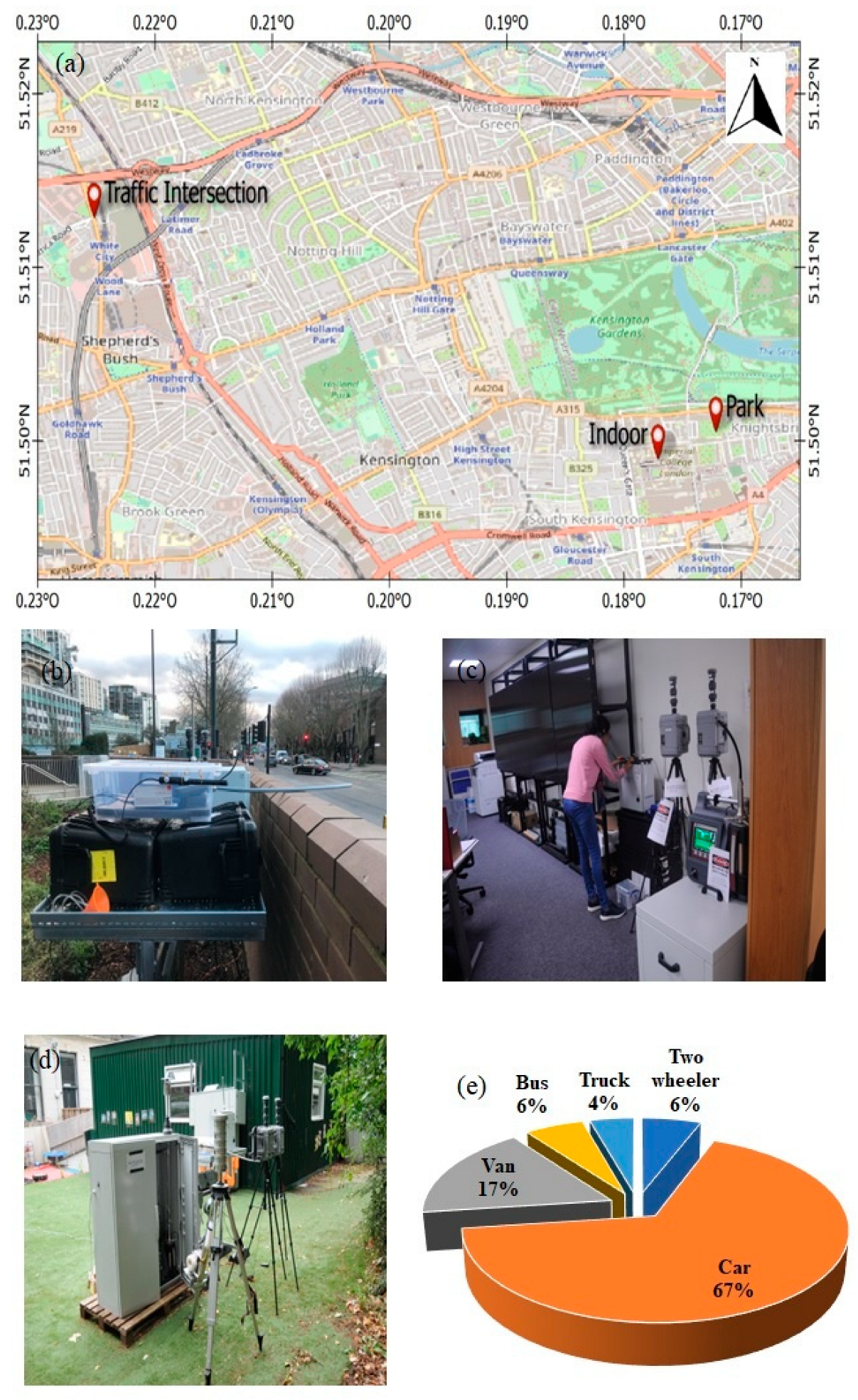

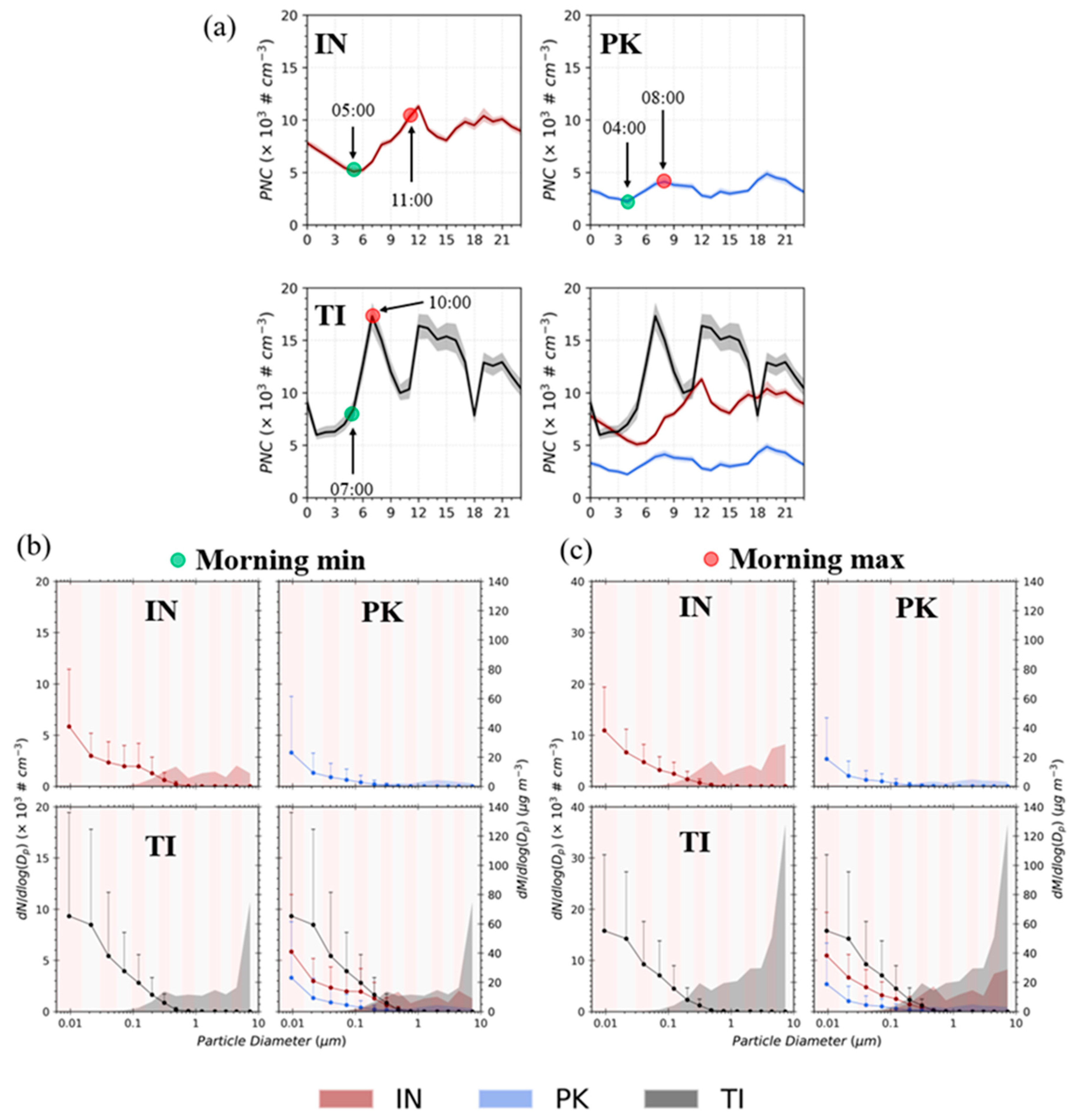
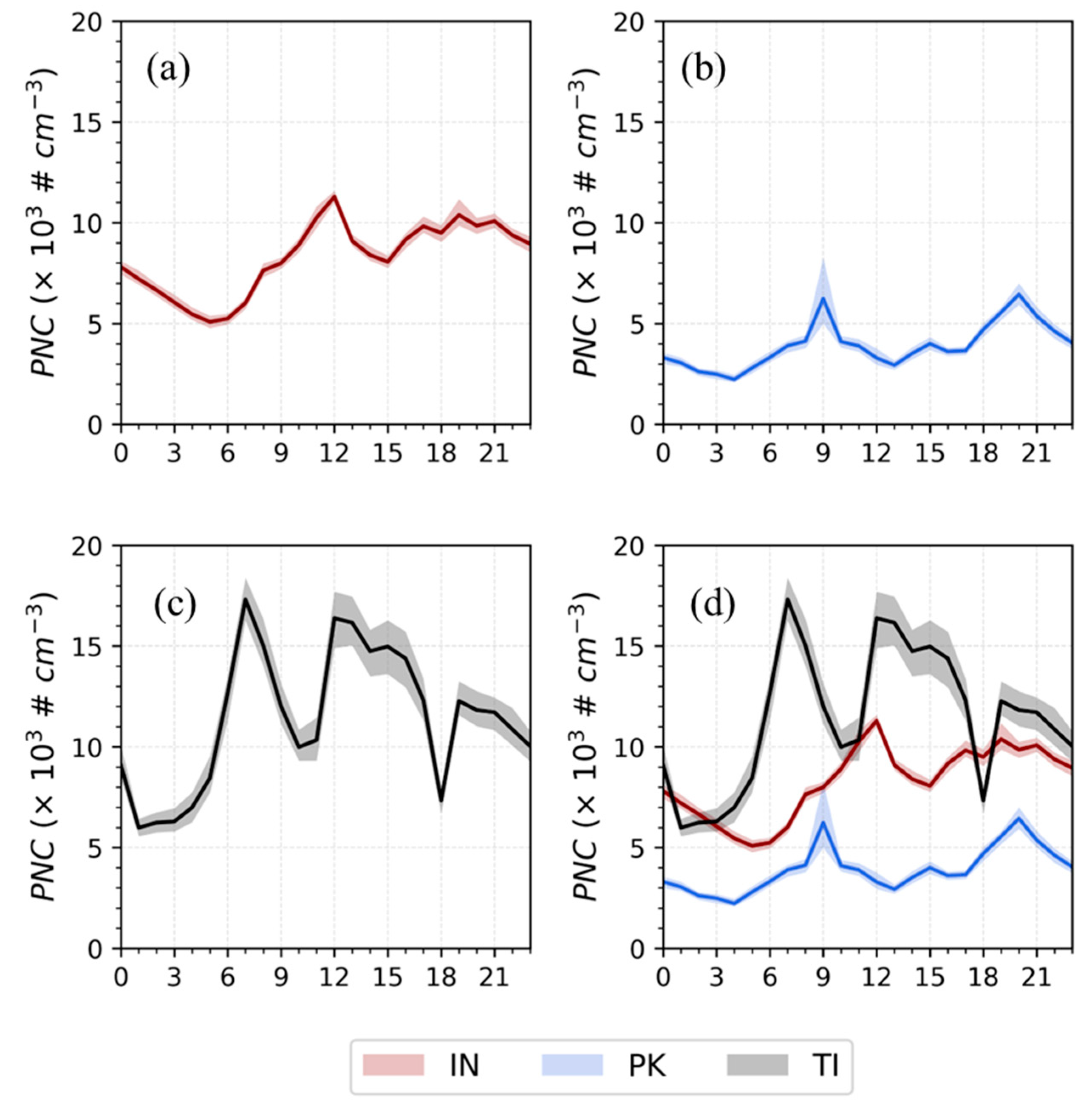
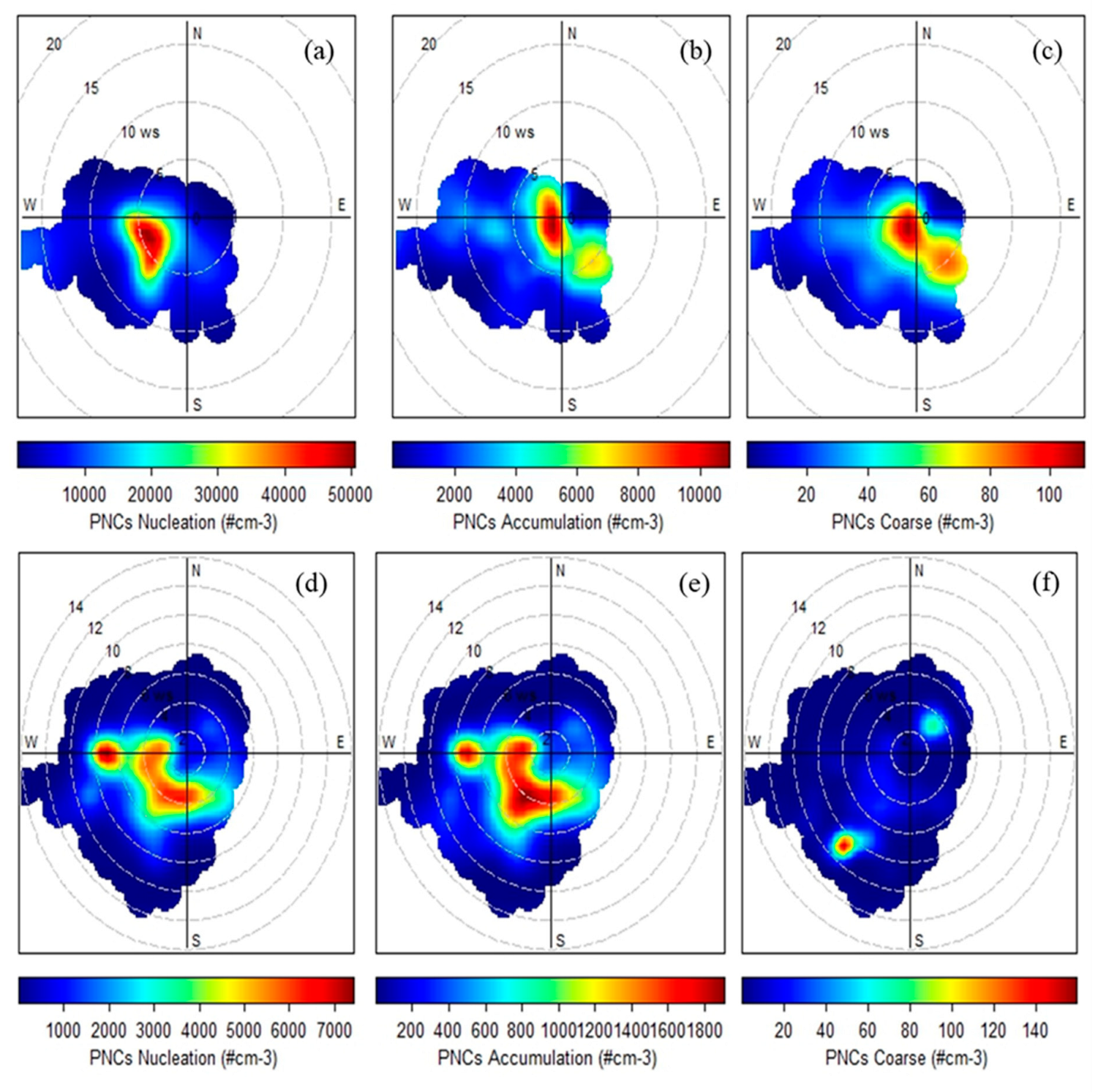
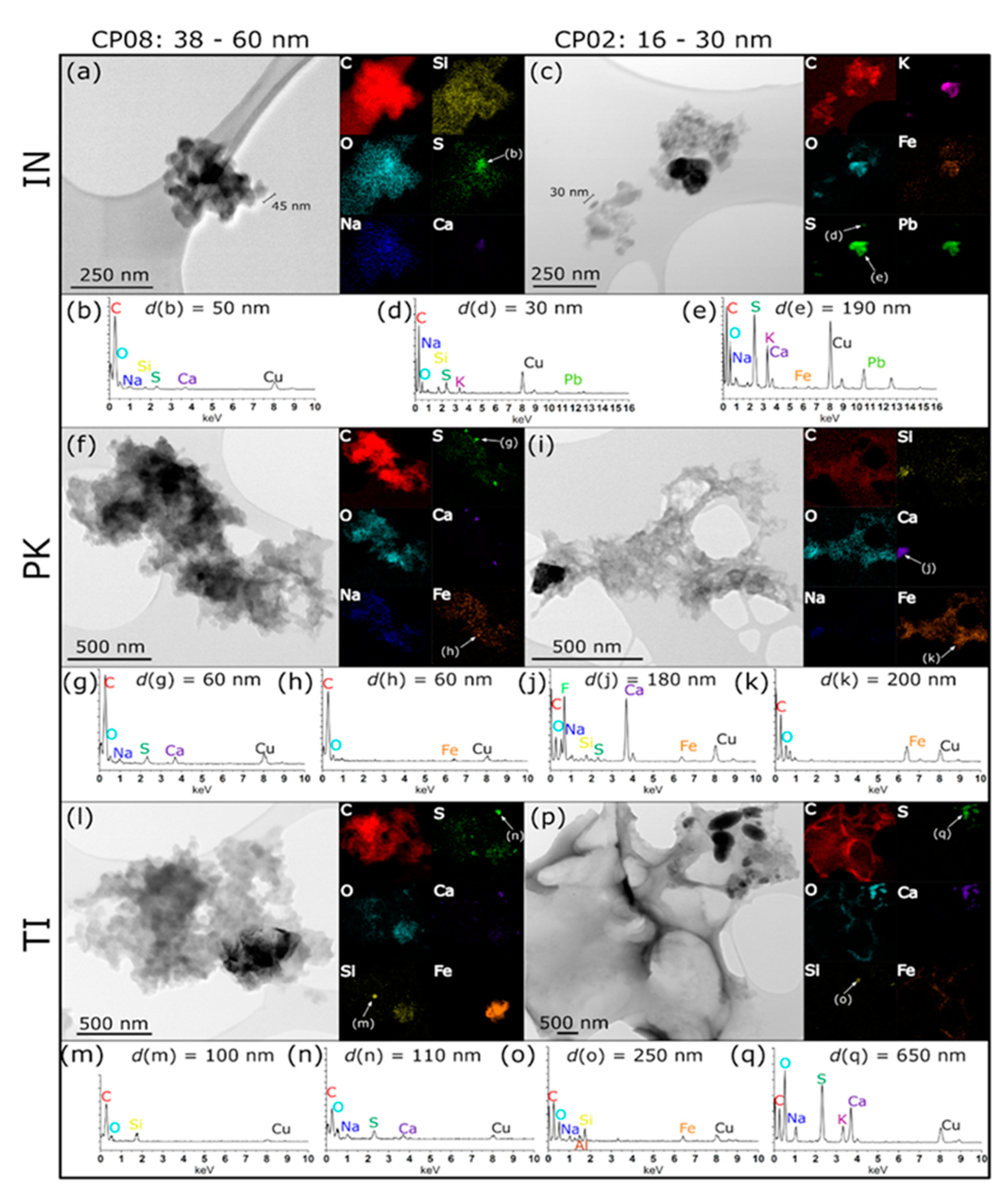
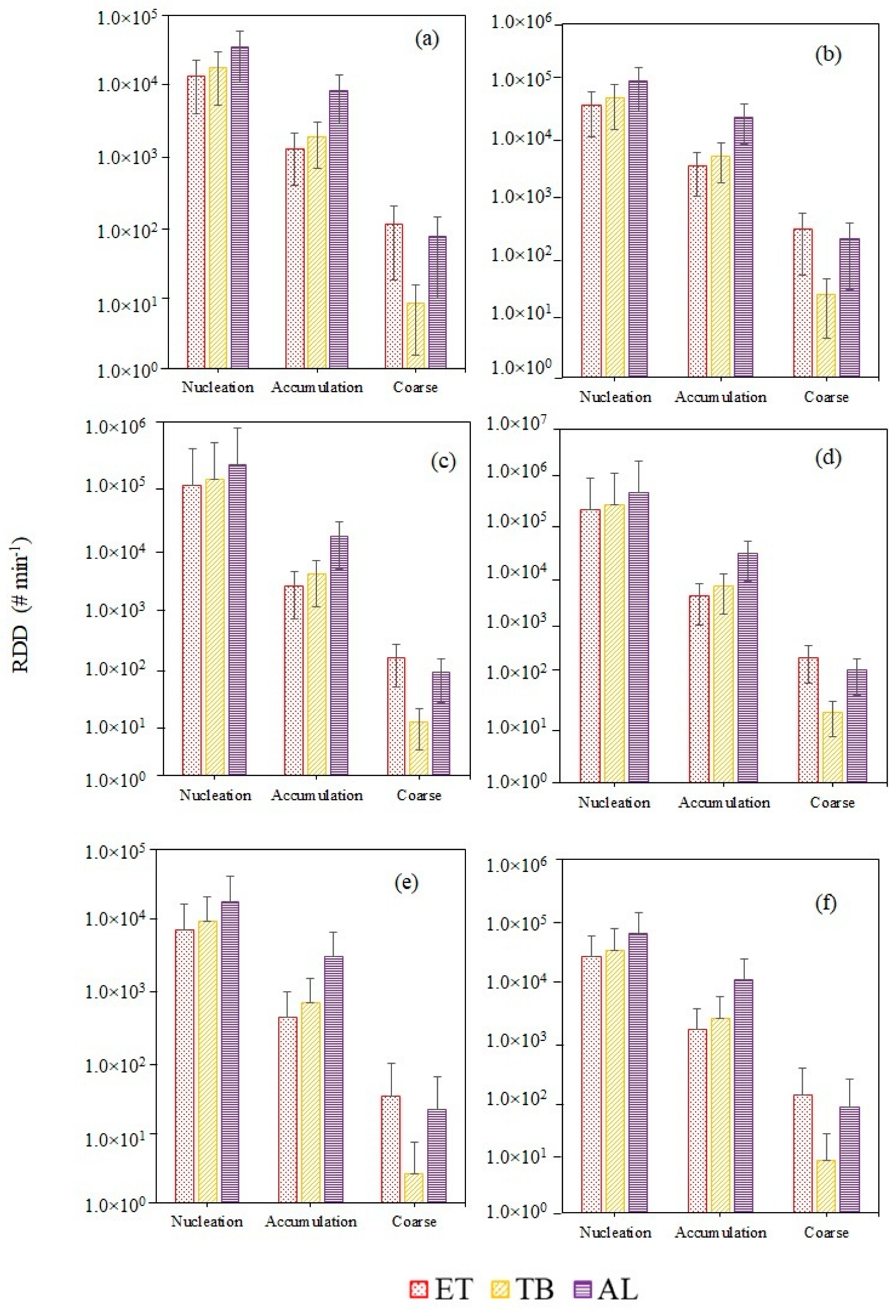
| Environment | Instrument (Size Range) | Description | Reference |
|---|---|---|---|
| Residential area | Scanning mobility particle sizer (SMPS) (16–698 nm) | Long-range transport (LRT) events possess the highest particle size, followed by secondary biogenic (BIO), wood-burning (WB), and traffic (TRA) events with geometric mean diameters of 72, 62, 57, and 41 nm, respectively. The contribution of WB was found to be dominant followed by TRA, BIO, or LRT aerosols. | [19] |
| Indoor | Scanning mobility particle sizers (SMPS) (4–532 nm) | PM size distributions were measured for particles in the size range of 0.001–20 μm. PNCs were higher during propane-fuelled cooking exhibiting particles in the sub 10 nm diameter. | [20] |
| Roadside with green infrastructures (GIs) | P-Trak 8525 (20–1000 nm) | The PNCs were reduced by up to 30% within the mixed configuration of trees and hedges. | [21] |
| Transport, indoor and outdoor | DiSCmini (10–300 nm) | The mean PNCs were highest in environments with motorised transport followed by indoor environments and walking outdoors. The peak contribution occurred 88% indoors (mainly at home) and 12% outdoors. | [18] |
| Indoor (metallurgical production site vicinity) | ELPI+ (0.007–10 μm) | Most of the particles are smaller than 1c and approximately 5 wt% are so-called ultrafine aerosols. The average aerodynamic diameters for the FeS and the SiMn fume particles were 0.17 and 0.10 μm, respectively. | [22] |
| Roadside with GIs | DMS50 (5–2500 nm) | The PNDs displayed dominant peaks at 5.6 and 10 nm and a varying peak in the 55–75 nm range. The PNCs were reduced by about 37% in the presence of GIs. | [23] |
| Different transport modes | DiSCmini (10–300 nm) | Average trip UFP concentrations were higher in cars (31,784 particles cm−3) and on bicycles (22,660 particles cm−3) compared to walking (19,481 particles cm−3) and public transportation (14,055–18,818 particles cm−3). | [24] |
| Indoor | FMPS (5.6–560 nm) | The characteristics of UFPs emitted from printers depend on indoor ventilation conditions. The number of concentrations of UFPs was increased due to reduced ventilation rates of indoor air. | [25] |
| Different transport modes (bus, car, and walking) | Condensation particle counters (CPCs) (10–1000 nm) | The highest measured mean concentrations were during walking and moving in motorised vehicles (bus and car). The lowest exposures were in green areas and office microenvironments. | [26] |
| Roadside | DMS 500 (5–1000 nm) | The PNCs were measured on roadsides at three different heights (i.e., 0.20 m, 1.0 m, and 2.60 m). The real-time particle number distributions (PNDs) in the 5–1000 nm range were found to be similar at each sampling height, showing a consistent and discernible decrease with the sampling height. | [27] |
| Roadside | DMS500 (5–1000 nm) | Aitken-mode particle concentrations decayed exponentially with increasing wind speed at roadside locations. The nucleation-mode particle concentrations at roadsides show a decaying relationship due to the dispersive effects of wind speed and distance from the local emission source. | [28] |
| Indoor | Condensation particle counters (CPCs) (10–1000 nm) | The highest mean indoor concentrations were in a small carpet-covered library and a teachers’ office in the school. Children attending primary school in the Athens area are exposed to significant levels of UFPs. | [17] |
| Environment (Code) | Sampling Site (Lat, log) | Campaign Duration |
|---|---|---|
| Indoor (IN) | DSI, William Penney Laboratory, Imperial College, South Kensington (51.498928, −0.177117). | 14 January 2020–31 January 2020 |
| Traffic intersections (TI) | The Invention Rooms, Imperial College, White City (51.512833, −0.225196). | 03 February 2020–21 February 2020 |
| Park/urban background (PK) | Princes Gardens, Imperial College, Knightsbridge (51.500512, −0.172176). | 24 February 2020–19 March 2020 |
| Particle Size Range | IN (#cm−3) | TI (#cm−3) | PK (#cm−3) | |||||||||
|---|---|---|---|---|---|---|---|---|---|---|---|---|
| Mean ± SD | Median | Max | Min | Mean ± SD | Median | Max | Min | Mean ± SD | Median | Max | Min | |
| N6–30 nm | 5682 ± 3902 | 4451 | 16,325 | 1644 | 31,521 ± 95,275 | 2073 | 38,8419 | 2505 | 2933 ± 3705 | 257 | 12,325 | 5 |
| N30–300 nm | 2694 ± 1806 | 1887 | 7438 | 1043 | 3468 ± 2490 | 2832 | 9857 | 1246 | 867 ± 1092 | 173 | 3828 | 2 |
| N(300–10,000 nm) | 63 ± 55 | 49 | 203 | 3 | 45 ± 30 | 35 | 120 | 17 | 17 ± 32 | 2 | 122 | 0.1 |
Disclaimer/Publisher’s Note: The statements, opinions and data contained in all publications are solely those of the individual author(s) and contributor(s) and not of MDPI and/or the editor(s). MDPI and/or the editor(s) disclaim responsibility for any injury to people or property resulting from any ideas, methods, instructions or products referred to in the content. |
© 2023 by the authors. Licensee MDPI, Basel, Switzerland. This article is an open access article distributed under the terms and conditions of the Creative Commons Attribution (CC BY) license (https://creativecommons.org/licenses/by/4.0/).
Share and Cite
Kalaiarasan, G.; Kumar, P.; Tomson, M.; Zavala-Reyes, J.C.; Porter, A.E.; Young, G.; Sephton, M.A.; Abubakar-Waziri, H.; Pain, C.C.; Adcock, I.M.; et al. Particle Number Size Distribution in Three Different Microenvironments of London. Atmosphere 2024, 15, 45. https://doi.org/10.3390/atmos15010045
Kalaiarasan G, Kumar P, Tomson M, Zavala-Reyes JC, Porter AE, Young G, Sephton MA, Abubakar-Waziri H, Pain CC, Adcock IM, et al. Particle Number Size Distribution in Three Different Microenvironments of London. Atmosphere. 2024; 15(1):45. https://doi.org/10.3390/atmos15010045
Chicago/Turabian StyleKalaiarasan, Gopinath, Prashant Kumar, Mamatha Tomson, Juan C. Zavala-Reyes, Alexandra E. Porter, Gloria Young, Mark A. Sephton, Hisham Abubakar-Waziri, Christopher C. Pain, Ian M. Adcock, and et al. 2024. "Particle Number Size Distribution in Three Different Microenvironments of London" Atmosphere 15, no. 1: 45. https://doi.org/10.3390/atmos15010045







